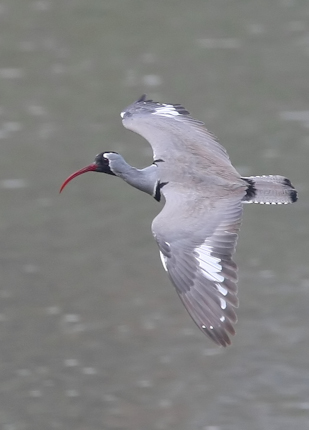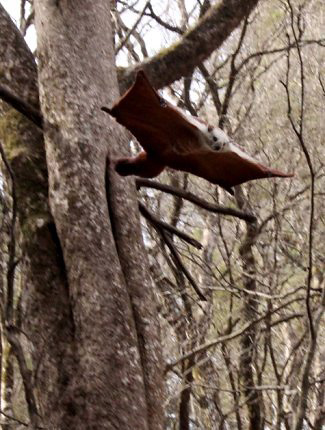

A rare photograph of a wild Giant Panda, taken in the Foping Reserve by Coke & Som Smith when foreign visitors were welcomed.
- A slim chance of seeing a wild Giant Panda
- A good chance of Golden Snub-nosed Monkey, as well as Golden Takin, Chinese Serow and Chinese Goral
- And a few of Asia's and the world's most spectacular birds including Asian Crested Ibis, Crested Kingfisher, Red-billed Blue Magpie and Gould's Sunbird, as well as, possibly, Temminck's Tragopan, Golden Pheasant, Ibisbill, Indian Blue Robin and Blackthroat
- In some scenic mountains with some of the world's most pristine forests
- Please be aware that parks and reserves in China are subject to random and unpredictable closures. For example in Central China, the core area of Foping NNR, which probably supports the greatest density of Giant Pandas in the world and is therefore the best place to look for them in the wild, has been closed to tourists since the early 2010s. If Foping ever opens again it will no doubt be essential to book visits several months in advance.
- For many years people travelled to the famous Wolong Reserve in Sichuan province, China with the faint hope of seeing a wild Giant Panda. Very few visitors returned with even a glimpse to remember, because much of the rugged, forested mountain terrain in Wolong is inaccessible and even in the areas visitors can reach Giant Pandas lead almost entirely solitary lives, wandering around about five square kilometres, from one dense bamboo thicket to the next, and once they find the best bamboo they sit there for hours, in the midst of it, eating it, which makes them one of the hardest animals to see in the wild. Then the core area of Foping NNR in the Qinling Mountains of neighbouring Shaanxi province was opened to tourists and many people got to see one of the planet's most extraordinary animals, then it was, for no apparent reason, closed to tourists. Should it be opened again it remains the best place to look. It may be remote – it is an 11 kilometre trek from the nearest road to the accommodation at the research station - and looking for Giant Pandas from there may involve many more hours on foot, often off-trail, in the sometimes snowy, rough terrain, but a high percentage of the small groups of visitors who were allowed in, with local trackers, came out with smiles on their faces, having seen a Giant Panda in the wild!
- China is a huge country, the third largest in the world, with a birdlist of over 1400, and there are several other great birding destinations. In nearby Sichuan and Tibet there are many spectacular birds and mammals; The rare Black-crested and Hoolock Gibbons, as well as Yunnan Snub-nosed Monkey and Phayre’s Leaf Monkey occur in Yunnan, the most bird-rich province in China; If arriving in China or departing China via Beijing it may be worth visiting the nearby Bai He River for a chance of Ibisbill; Beidaihe and Happy Island, on the northeast coast a few hours from Beijing, lie on one of the world's major bird migration routes where in spring (mostly in May) and autumn (mostly in September) it is possible to experience migration in action with falls of numerous birds; during the northern winter Hooded, Siberian and White-naped Cranes, as well as Oriental Stork, occur at Poyang Hu, a huge inland lake in Eastern China, with the rare Scaly-sided Merganser on the nearby Xin River; and in southeastern China it is possible to see Spoon-billed Sandpiper during the northern winter, and Chinese Crested Tern and White-faced Plover during the northern spring and summer on the Minjiang Estuary near Fuzhou, White-eared Night-heron at Jiulianshan, Cabot’s Tragopan at Wuyishan and, especially in April, in Hong Kong, one of the best shorebird shows left on Earth, possibly including Spoon-billed Sandpiper, as well as Asian Dowitcher, Spotted (Nordmann’s) Greenshank and Great Knot, along with other birds such as Black-capped Kingfisher and Black-faced Spoonbill, plus ‘pink’ Indo-Pacific Humpback Dolphins;
Best Birds and other wildlife in Central China
Mammals
Golden Snub-nosed Monkey, Golden (Sichuan) Takin, Chinese Serow, Chinese Goral, Forest Musk and Tufted Deer,
Reeve's Muntjac, Leopard Cat, Tibetan Macaque, Malayan Porcupine, Chinese Ferret Badger, Hog Badger, Masked Palm Civet and Confucian Niviventer. Also
a slim chance of Giant Panda (most likely Feb-Jun and Aug-Nov, especially mid-March to April, and the first half of November), as well as Red-and-white
Flying Squirrel, (Asiatic) Black Bear and Yellow-throated Marten.

There are plenty of great birds to see in addition to the mammals in Central China, not least Ibisbill. This great flight shot was taken by Roger Wyatt.
Birds
Endemics
Chinese Bamboo Partridge, Golden Pheasant, Asian Crested Ibis (being reintroduced to Japan), Three-toed Parrotbill, Spectacled Parrotbill, Rusty-throated
(Przewalski's) Parrotbill, Sichuan Treecreeper and Slaty Bunting.
(Blackthroat breeds in north-central China. Its non-breeding grounds are unknown but it has been recorded in northwest Thailand although possibly only as a vagrant)
Other specialities
Temminck's Tragopan, Ibisbill, Crested Kingfisher, Asian Azure-winged Magpie, Wallcreeper, Collared Finchbill, Fulvous and Vinous-throated Parrotbills,
Chinese Babax, Fork-tailed Sunbird and Yellow-throated Bunting. Also a chance of Indian Blue Robin, White-bellied Redstart and Maroon-backed Accentor.
Others
Chinese Pond-heron, Golden Eagle, Grey-headed Lapwing, Black-capped Kingfisher, woodpeckers including White-backed, Long-tailed Minivet, Red-billed Blue
Magpie, Black-throated and Fire-capped Tits, Brown Dipper, Plumbeous and White-capped Water-redstarts, Little and White-crowned Forktails,
laughingthrushes, Streak-breasted Scimitar-babbler, Pygmy Cupwing, Red-billed Leiothrix, Green Shrike-babbler, Golden-breasted Fulvetta, Southern
Nutcracker, Gould's Sunbird and White-winged Grosbeak. Also a chance of Koklass Pheasant, Mandarin Duck, Long-billed Plover, Great Parrotbill and
Grey-headed Bullfinch.
Species present during the northern summer only include Cinnamon Bittern, White-throated Needletail, (Oriental) Dollarbird, Brown-rumped (Swinhoe's) Minivet, Fujian and Rufous-bellied Niltavas, Firethroat and Forest Wagtail.
Plants
Numerous spectacular rhododendrons, which most usually flower in April and
cover whole mountain slopes in places.
Best Sites for Birds, pandas and other wildlife in Central China
- Xi'an Area (where the Terracotta Warriors are situated)
- Cham River Asian Azure-winged Magpie.
- Qinling Mountains
- Zhou Zhi NNR A slim chance of Golden Snub-nosed Monkey.
- Laoxiancheng NNR A slim chance of Giant Panda, 'Golden' Takin, and Golden and Koklass Pheasants.
- To Foping NNR Ibisbill. Also a chance of Long-billed Plover.
- Foping NNR Golden Snub-nosed Monkey (in 'Monkey Valley' outside the core area where a large troop has been habituated to the hordes of human visitors at a 'feeding station'), Red-billed Blue Magpie, forktails, laughingthrushes, Streak-breasted Scimitar-babbler, Chinese Babax, Red-billed Leiothrix, Green Shrike-babbler, Golden-breasted and Spectacled Fulvettas, Fulvous, Great and Spectacled Parrotbills, Fork-tailed and Gould's Sunbirds, and Slaty Bunting. Also a slim chance of Giant Panda, Red-and-white Flying Squirrel, (Asiatic) Black Bear, Golden Takin, Leopard Cat, Yellow-throated Marten, Temminck's Tragopan, Golden and Koklass Pheasants, Indian Blue Robin, White-bellied Redstart and Blackthroat (mid-May at Liangfengya, not always open to tourists). Other summer visitors include White-throated Needletail and Firethroat.
- Taibai Shan NFR Sichuan Treecreeper, Slaty Bunting and White-winged Grosbeak. Also a chance of Temminck's Tragopan, Golden Pheasant, Spectacled Parrotbill and Maroon-backed Accentor.

A great photograph of a Red-and-white Flying Squirrel in flight, taken in the Foping Reserve by Coke & Som Smith.
- Yangxian Asian Crested Ibis and Chinese Pond-heron.
- Far North Sichuan
- Tangjiahe Panda Reserve Golden Takin, Chinese Serow, Chinese Goral, Forest Musk and Tufted Deer, Reeve's Muntjac, Leopard Cat, Tibetan Macaque, Malayan Porcupine, Chinese Ferret Badger, Hog Badger, Masked Palm Civet, Confucian Niviventer, Crested Kingfisher, Little Forktail, Pygmy Cupwing, Golden-breasted Fulvetta and Gould's Sunbird. Also a chance of Golden and Koklass Pheasants, Indian Blue Robin, and Rusty-throated, Spectacled and Three-toed Parrotbills.
Best Times for Birds, pandas and other wildlife in Central China
The peak times to look for Giant Panda are mid-March to April, when the females are in oestrus and being sought by males and before the growing thickness of the vegetation makes them even more difficult to see, and the first half of November, when the vegetation becomes less thick and before the winter weather sets in and makes getting about on foot much more difficult. The peak time to look for truly wild Golden Snub-nosed Monkeys is October-November, when they usually move to lower altitudes for the winter. Unfortunately neither mid-March to April nor October-November coincide with the peak time for birds, which is late May and June, when summer visitors including are present and the territories of high altitude specialities such as Temminck's Tragopan are more accessible.
Recommended Bird Books etc. for Central China
Mammals of China (Pocket Edition) edited by A Smith and Y Xie. PUP, 2013.
A Guide to the Mammals of China by A Smith, Y Xie et al. PUP, 2008.
The Mammals of China by Sheng Helin et al. China Forestry Publishing House, 1999.
Bradt Travel Guide: Chinese Wildlife by M Walters. Bradt, 2008.
A Field Guide to the Birds of China by J MacKinnon and K Phillipps. OUP, 2000.
Helm Field Guide: Birds of East Asia by M Brazil. Helm, 2009.
Where to watch birds in Asia by N Wheatley. Helm, 1996.
Don’t know which country/countries/regions to visit in Asia? Then it may be worth considering taking a look at this book, written by this website’s author. It is many years old of course but it still provides a starting point, an overview and a guiding light to the best birds and the best places to look for them in the region, and could save hours of searching for similar information on the internet. However, it is important to check more up-to-date sources for sites which have been opened up, sites and species which have been discovered, lodges that have been built etc. since the book was published.
Birding and Wildlife Trip Reports for Central China
Many trip reports, some for Central China, are posted on the websites listed here. On some of these websites some reports are independent and some are posted by tour companies who organize tours to Central China. These tour companies and others also post their own reports on their websites, which are listed under 'Some Organized Tours to Central China' below.
- The best website for trip reports is CloudBirders
- but these are also worth a look
- Birdtours
- Fatbirder
- Jon Hornbuckle
- Mammal Watching
Local bird, panda and wildlife guides in Central China
The costs of organized tours partly reflect the quality of the tour leaders. Some leaders are certainly better than others and many companies claim their leaders are the best but even the best rely at least to some extent on the exceptional skills of the local guides they employ. If you are travelling independently, employing such local guides will greatly increase your chances of seeing the wildlife you wish to see.
- China Bird Tour
- China based birding tour company since 1999 specializing in providing local arrangements for worldwide birding companies and individual birders within China, including all hot spots.
Accommodation for birders and panda watchers in Central China
Some Organized Tours for birds, pandas and other wildlife to Central China
There are many tour companies who organize tours to see mammals, birds, other wildlife and other natural wonders. The cost of these tours vary considerably according to such variables as the airlines used, the number of days the tours last, the number of sites visited, the number of people in the group (an important consideration if you wish to see such wildlife as rainforest mammals and birds), the number of tour leaders, the standard of accommodation and transport, and the percentage profit the company hopes to make. Generally, where the number of days tours last and the number of sites visited are similar, the cheapest tours are those that use the cheapest airlines, accommodation and local transport, that have the largest groups with the least number of leaders, and that make the least amount of profit. The most expensive tours tend to be those which are exceptionally long, use the most expensive accommodation (ridiculously lavish in some cases, even for single nights) and which make the most profit. Some tour costs partly reflect the quality of the tour leaders. Some leaders are certainly better than others and many companies claim their leaders are the best but even the best rely at least to some extent on the exceptional skills of the local guides they employ.
While tour companies organize tours with set itineraries many also organize custom tours for individuals and private groups who instead of taking a tour with a set itinerary want to follow their own itinerary to suit their own personal tastes, whether it be mammals, birds, other wildlife, other natural wonders or even man-made attractions, or a mixture of them all. Many organized tours with set itineraries are also fast-paced and target as many species as possible, whether they are mammals, birds or other wildlife or everything, which usually leaves little time to enjoy the best sites and individual species, but on a custom tour those taking part can specify the pace and the sites and species they wish to concentrate on. Custom tours also suit people who like to travel with people they already know, rather than with a group of strangers, and people with partners with different interests. Individuals and small groups will almost certainly have to pay more than the price of an organized tour with a set itinerary but a large group of friends may be able to travel for less than the price quoted for a set tour.
Tour companies who run organized tours or can arrange custom tours to Central China include the following.
